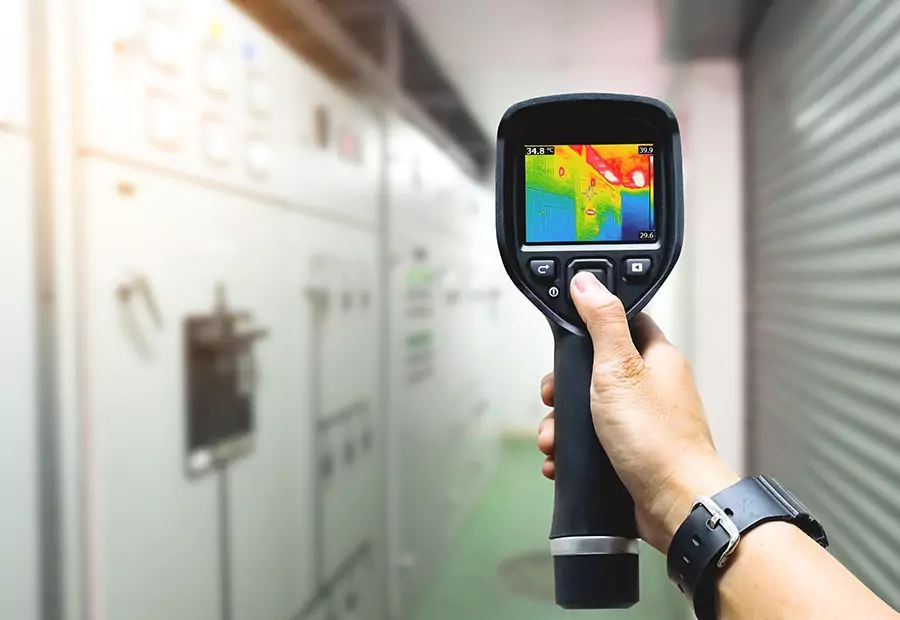When purchasing or maintaining a home, a thorough inspection is essential to ensure the property is in good condition. Traditional home inspections are effective, but they can sometimes miss problems lurking beneath the surface. Enter home inspection with thermal imaging, a cutting-edge method that allows inspectors to detect hidden issues that might not be visible to the naked eye. In this blog post, we’ll explore the advantages of thermal imaging in home inspections, helping homeowners uncover potential risks before they become costly repairs.
What is Thermal Imaging in Home Inspections?
Thermal imaging, also known as infrared (IR) thermography, is a technology that detects heat patterns and temperature differences on surfaces. This can be particularly helpful in identifying issues within a home that aren’t easily visible, such as hidden moisture, electrical problems, or insulation gaps.
During a home inspection with thermal imaging, an inspector uses a thermal camera to capture images that reveal temperature variations. These temperature differences can highlight potential problems like water leaks, energy inefficiency, or even electrical hazards. While a traditional inspection relies on sight, smell, and touch, thermal imaging adds an extra layer of insight, making it a powerful tool for a more comprehensive assessment.
How Thermal Imaging Works
Thermal cameras pick up infrared radiation, which is invisible to the human eye but is present in all objects that emit heat. By translating this infrared data into visible light images, inspectors can “see” temperature differences in various parts of a home. For example, a wet area in a wall may show up as a cooler spot, signaling a potential water leak. The technology itself is non-invasive, meaning there’s no need to open walls or disturb insulation, allowing inspectors to gather data without causing any damage.
Why It’s Important for Homeowners
A home inspection with thermal imaging provides valuable information that a basic inspection might miss. It can reveal underlying problems early on, enabling homeowners to address them before they worsen. Additionally, this method gives homeowners peace of mind, knowing their property has been thoroughly examined, including hard-to-reach areas.
Identifying Moisture Problems
Hidden Leaks and Water Damage
Water damage can wreak havoc on a home, leading to mold growth, structural issues, and costly repairs. Unfortunately, water damage is not always easy to detect, especially if it’s happening behind walls or under floors. Home inspection with thermal imaging is a game-changer in detecting moisture problems before they become severe.
With thermal imaging, inspectors can identify areas where moisture is accumulating, even if there’s no visible sign of a leak. A thermal camera can show cooler areas that may indicate the presence of water, allowing for further investigation. For example, a leak in the plumbing system might not be noticeable on the surface, but the surrounding wall will show a cooler temperature due to the moisture trapped inside.
Preventing Mold Growth
Mold thrives in damp environments, and it can pose significant health risks to occupants, especially those with respiratory issues. Because mold can grow in areas that are hidden from view, it often goes unnoticed until it becomes a major problem. Thermal imaging can identify potential mold-friendly environments by detecting excess moisture behind walls, ceilings, or floors. Catching these damp areas early allows homeowners to take action and prevent mold growth before it becomes a serious concern.
Enhancing Energy Efficiency
Detecting Insulation Issues
Another significant benefit of home inspection with thermal imaging is its ability to detect insulation problems. Insufficient or improperly installed insulation can lead to heat loss during winter and excess heat gain in the summer, which in turn drives up energy bills. Thermal imaging can reveal areas where insulation is lacking, showing temperature differences between insulated and non-insulated parts of the home.
Inspectors can use thermal imaging to identify cold spots in the walls or attic, where heat is escaping during winter. Similarly, during the warmer months, the technology can detect hot spots in the home, indicating poor insulation. Once these areas are identified, homeowners can address the issue, improving the overall energy efficiency of their property.
Finding Air Leaks
Air leaks are another common cause of energy inefficiency. Gaps around windows, doors, or in the roof can let conditioned air escape, forcing heating and cooling systems to work harder. This not only results in higher energy costs but also makes it harder to maintain a comfortable indoor environment. A home inspection with thermal imaging can reveal these air leaks by showing temperature differences around the home’s exterior. By identifying and sealing these leaks, homeowners can save money on their energy bills and reduce their carbon footprint.
Improving Electrical Safety
Identifying Overheating Electrical Components
Electrical problems are a leading cause of house fires, and they can be difficult to detect during a standard visual inspection. Worn-out wiring, overloaded circuits, and malfunctioning electrical panels can all lead to overheating, which poses a serious safety risk. A home inspection with thermal imaging can help detect these issues before they become dangerous.
Thermal cameras can capture heat patterns that reveal areas where electrical components are running too hot. If an inspector notices an unusually warm spot around wiring or an electrical panel, it could indicate an overloaded circuit or faulty wiring that needs attention. By identifying these problems early, homeowners can address them before they pose a fire hazard.
Reducing Electrical System Failures
In addition to preventing fires, thermal imaging can help reduce electrical system failures. Overheating components can lead to system breakdowns, causing inconvenience and potential costly repairs. By pinpointing areas of concern, thermal imaging allows for targeted maintenance, ensuring the electrical system runs smoothly and efficiently.
Conclusion: A Smart Investment for Homeowners
A home inspection with thermal imaging is an invaluable tool for uncovering hidden issues in a home. Whether it’s detecting moisture problems, improving energy efficiency, or identifying electrical hazards, thermal imaging provides a deeper level of insight than traditional inspections alone. Homeowners can benefit greatly from this advanced technology, as it helps prevent costly repairs, enhances safety, and promotes a healthier living environment.
While thermal imaging is not yet a standard part of every home inspection, it’s a smart investment for those looking to protect their homes and ensure everything is running smoothly. By opting for this service, homeowners can gain peace of mind, knowing their property has been thoroughly examined from top to bottom, inside and out.



